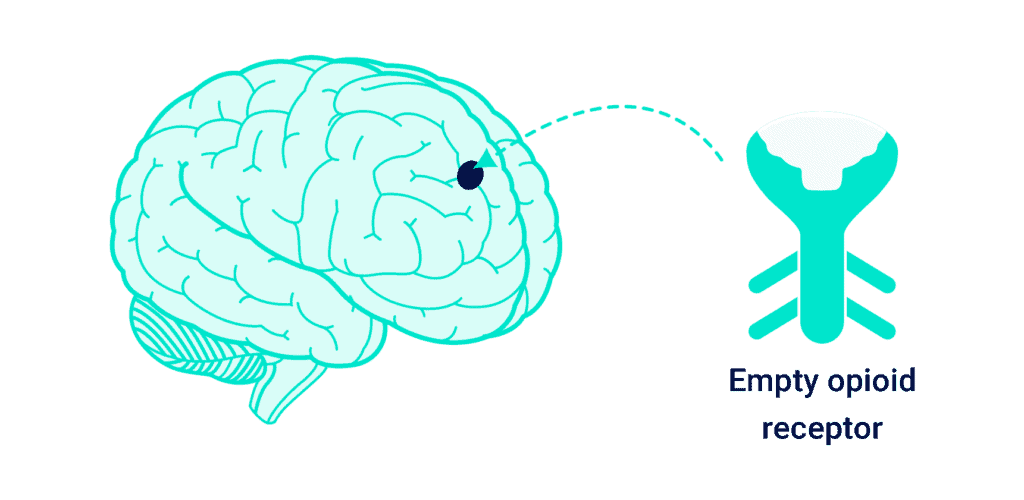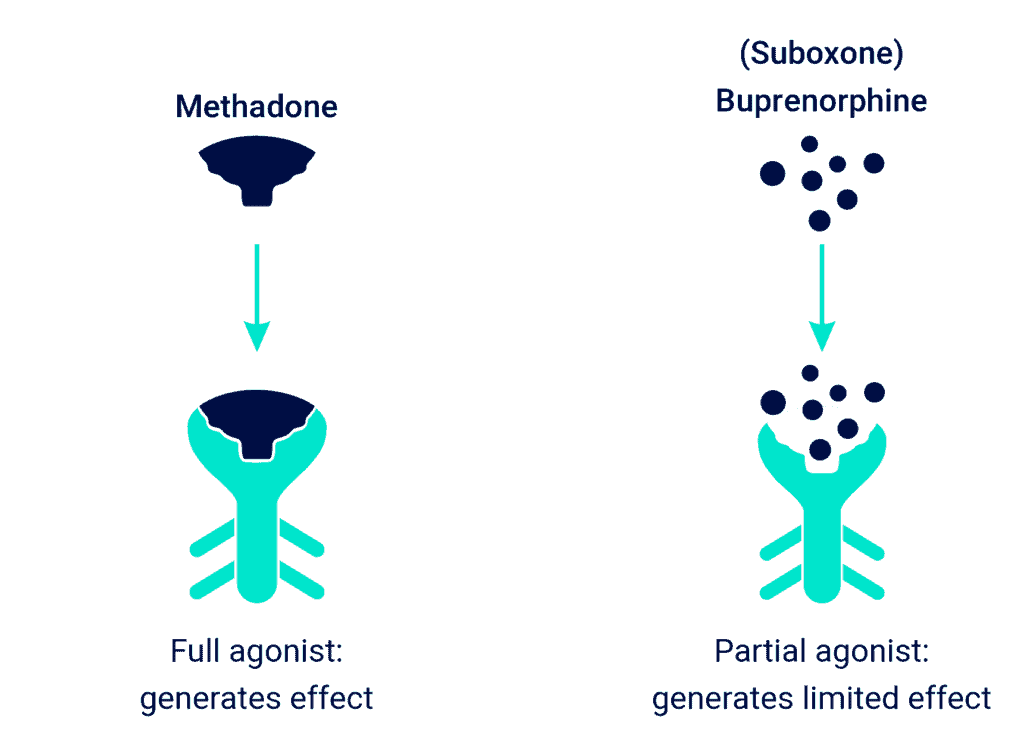Suboxone and methadone are two different medications that are both used to treat opioid use disorder.
- Suboxone is a combination of two medications: buprenorphine and naloxone.
- Buprenorphine is a partial-agonist opioid used to reduce cravings and withdrawal symptoms.
- Naloxone is an opioid blocker added to discourage abuse.
- Methadone is a synthetic opioid used to reduce cravings and withdrawals.
Is Suboxone the same as methadone?
No, but they share many similarities in treating the same condition, opioid use disorder.
- Suboxone and methadone both alleviate withdrawal symptoms during the first few days of detox.
- Both can also be taken every day as a long-term medication. As part of a maintenance program, people addicted to opioids can function in everyday life without being overwhelmed by cravings.
How Suboxone and Methadone Work in the Brain


What is the difference between methadone and Suboxone?
Even though both help people with opioid use disorder, they are different medications.
- Methadone is a full agonist opioid medication that binds to the same opioid receptors as drugs like heroin or OxyContin. When methadone binds to these receptors in the brain it calms cravings. But, methadone is long-acting and does not produce the same rush of euphoria as other opioids. See Also: How Long Does Methadone Stay in the Body
- Suboxone is a partial agonist opioid, which means it doesn't fully bind to the opioid receptors. It curbs cravings just as well as methadone but does not produce the "high". It also has a safeguard to protect against abuse, making it a safer option that has ewer requirements for visiting an in-person clinic.
| Medication | Methadone | Suboxone (Buprenorphine) |
| Mechanism | Full opioid (agonist) | Partial opioid (agonist) |
| Route of Administration | Oral (Dissolvable tablet, Pill, Liquid) | Film dissolved in mouth Oral Pill Injection in stomach (Subloclade) |
| Dosing | Daily | Daily for film / pill Monthly for injection |
| Available for Substance Use | Specialized Opioid Treatment Program (OTP) license | Doctors that apply for specialized certification |
Methadone is only dispensed at a methadone clinic.
Because it’s a full-agonist opioid, methadone is tightly regulated. Patients must report to a methadone clinic to get their dose dispensed to them. After several months of success, patients take home more methadone dosage over time and the requirement for check-ins end up similar to Suboxone eventually.ⓘ
See also: What is a Methadone Clinic?
Suboxone can be filled at the pharmacy like any other medication, but pharmacies too often refuse to provide Suboxone. A Suboxone clinic can dispense onsite.
See also: What is a Suboxone Clinic?
Suboxone is usually the first choice.
Suboxone is usually the first choice for opioid use disorder because it’s people are less likely to abuse it and the naloxone blocker prevents overdose in case they do. However, methadone has been successfully treating opioid addiction for years and is a good option if you’ve already had success with it. Some switch to methadone if they haven’t been successful with Suboxone or want the extra daily accountability.
Suboxone vs. Methadone FAQs
No, they are different medications with different ingredients.
- Methadone only has one ingredient, methadone hydrochloride.
- Suboxone is a combination of two medications, buprenorphine and naloxone.
Suboxone and methadone have similar side effects, including:
- Constipation
- Nausea and vomiting
- Drowsiness and fatigue
- Dilated pupils
- Insomnia
- Sweating
- Respiratory distress
- Double-vision
The biggest difference is that Suboxone doesn’t cause the feel-good, euphoric feelings of traditional opioids. It’s less intense than heroin or fentanyl, but you can get high off of methadone, which is why it’s given only at a clinic.
See also: Methadone Side Effects
Methadone and Suboxone are equally effective at treating opioid use disorder, though one study showed individuals on low doses of Suboxone (6 mg or less) are less likely to stay in treatment compared those taking methadone.ⓘ
Can you take methadone and Suboxone together?
No, you have to choose either Suboxone or methadone. Combining both medications is dangerous because both are opioids and because Suboxone contains naloxone, an opioid blocker.
This combination could cause an opioid / methadone overdose, but will more likely lead to severe precipitated withdrawal symptoms.
Combining Suboxone with methadone will not give you a high or relief, but will likely cause you to feel absolutely terrible including 10/10 body pain and vomiting.
See also: Drug Interactions with Methadone
Should you switch from methadone to Suboxone?
If a patient is successfully treating their opioid addiction with methadone, there is no need to switch to Suboxone. But, if they continue to relapse or are non-compliant with the methadone program, Suboxone may be a better fit.
- Buprenorphine (the opioid in Suboxone) is less likely to cause an overdose if abused.
-
Suboxone contains blocks the effects of opioids, which can help deter relapse when patients know they won't get the "high".
See also: How Does Suboxone Work? - It can be inconvenient to report to a methadone clinic every day in the beginning. (Though patients earn take-home doses over time, eventually checking in monthly just like Suboxone).
How To Switch From Methadone To Suboxone
Should you switch from Suboxone to methadone?
It’s not as common to switch from Suboxone to methadone, but can be a good option when patient’s aren’t successful on Suboxone.
How To Switch From Suboxone To Methadone
Switching from Suboxone to methadone is easier because methadone does not have an opioid blocker. Methadone should be started 24 hours after the last dose of Suboxone. The initial dose of methadone will be adjusted based on the patient’s last Suboxone dose.
See also: How to Get Off Suboxone
Discuss Your Medication Options
Symetria is a top-rated medication-assisted treatment (MAT) clinic, with locations throughout Chicago, as well as Fort Worth and Houston. All locations are in-network with insurances and offer both Suboxone and Methadone.
Get Methadone or Suboxone Here
Illinois Medication-Assisted Treatment
If you don’t happen to live in Illinois or Texas, try calling the number on the back of your insurance card. If you don’t have insurance, visit FindTreatment.gov and type in your zip code. Then, on the next page, use the free or slider scale filters.
40 Comments
I been in methadone 20 years due to circumstances I abruptly quit the clinic. I knew violent withdraws were coming so I masked them by doing heroin an fentanyl. It’s been 45 days no methadone. Should I try to taper the heroin instead of trying subs?
How long do withdrawals last when swapping over from 50 methadone to the the monthly injection